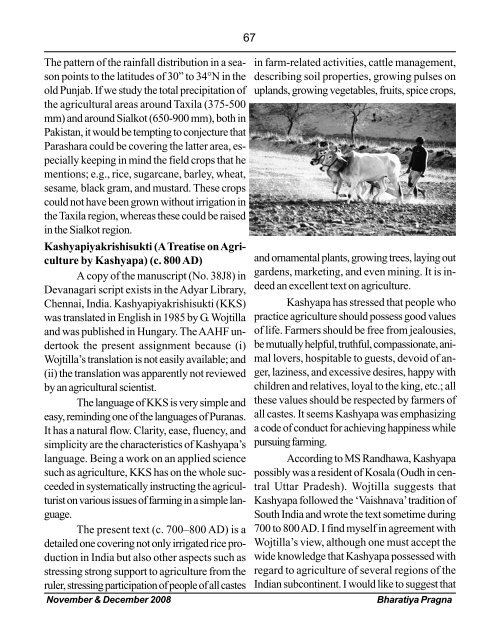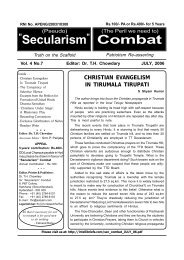Bharatiya Pragna - Dr. Th Chowdary
Bharatiya Pragna - Dr. Th Chowdary
Bharatiya Pragna - Dr. Th Chowdary
Create successful ePaper yourself
Turn your PDF publications into a flip-book with our unique Google optimized e-Paper software.
67<br />
<strong>Th</strong>e pattern of the rainfall distribution in a sea- in farm-related activities, cattle management,<br />
son points to the latitudes of 30” to 34°N in the describing soil properties, growing pulses on<br />
old Punjab. If we study the total precipitation of<br />
the agricultural areas around Taxila (375-500<br />
mm) and around Sialkot (650-900 mm), both in<br />
Pakistan, it would be tempting to conjecture that<br />
Parashara could be covering the latter area, especially<br />
keeping in mind the field crops that he<br />
mentions; e.g., rice, sugarcane, barley, wheat,<br />
sesame, black gram, and mustard. <strong>Th</strong>ese crops<br />
could not have been grown without irrigation in<br />
the Taxila region, whereas these could be raised<br />
in the Sialkot region.<br />
uplands, growing vegetables, fruits, spice crops,<br />
Kashyapiyakrishisukti (A Treatise on Agriculture<br />
by Kashyapa) (c. 800 AD) and ornamental plants, growing trees, laying out<br />
A copy of the manuscript (No. 38J8) in<br />
Devanagari script exists in the Adyar Library,<br />
gardens, marketing, and even mining. It is indeed<br />
an excellent text on agriculture.<br />
Chennai, India. Kashyapiyakrishisukti (KKS) Kashyapa has stressed that people who<br />
was translated in English in 1985 by G. Wojtilla practice agriculture should possess good values<br />
and was published in Hungary. <strong>Th</strong>e AAHF un- of life. Farmers should be free from jealousies,<br />
dertook the present assignment because (i) be mutually helpful, truthful, compassionate, ani-<br />
Wojtilla’s translation is not easily available; and mal lovers, hospitable to guests, devoid of an-<br />
(ii) the translation was apparently not reviewed ger, laziness, and excessive desires, happy with<br />
by an agricultural scientist.<br />
children and relatives, loyal to the king, etc.; all<br />
<strong>Th</strong>e language of KKS is very simple and these values should be respected by farmers of<br />
easy, reminding one of the languages of Puranas. all castes. It seems Kashyapa was emphasizing<br />
It has a natural flow. Clarity, ease, fluency, and a code of conduct for achieving happiness while<br />
simplicity are the characteristics of Kashyapa’s pursuing farming.<br />
language. Being a work on an applied science According to MS Randhawa, Kashyapa<br />
such as agriculture, KKS has on the whole suc- possibly was a resident of Kosala (Oudh in cenceeded<br />
in systematically instructing the agricultral Uttar Pradesh). Wojtilla suggests that<br />
turist on various issues of farming in a simple lan- Kashyapa followed the ‘Vaishnava’ tradition of<br />
guage.<br />
South India and wrote the text sometime during<br />
<strong>Th</strong>e present text (c. 700–800 AD) is a 700 to 800 AD. I find myself in agreement with<br />
detailed one covering not only irrigated rice pro- Wojtilla’s view, although one must accept the<br />
duction in India but also other aspects such as wide knowledge that Kashyapa possessed with<br />
stressing strong support to agriculture from the regard to agriculture of several regions of the<br />
ruler, stressing participation of people of all castes Indian subcontinent. I would like to suggest that<br />
November & December 2008 <strong>Bharatiya</strong> <strong>Pragna</strong>



